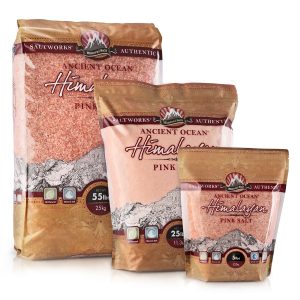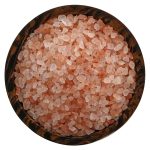SaltWorks Inc. Warns Retailers of Influx of Lower Quality Himalayan Salt
SPONSORED CONTENT
 SaltWorks® CEO Mark Zoske is warning retailers and wholesale buyers that an influx of lower cost, poorly processed, low-quality Himalayan pink salt has infiltrated the market, putting businesses and consumers at risk.
SaltWorks® CEO Mark Zoske is warning retailers and wholesale buyers that an influx of lower cost, poorly processed, low-quality Himalayan pink salt has infiltrated the market, putting businesses and consumers at risk.
Prized for its beautiful gradient of color, trace mineral content and delicious flavor, Himalayan salt has exploded in popularity, especially as consumers seek all-natural salts that contains no artificial additives.
Responding to the increased demand, commodity importers have introduced poorly processed mineral salt that may contain undesirable and potentially harmful insoluble materials, such as dust, dirt, clay, stone, rocks or even plastic and metal fragments.
“Some larger retailers are pressuring suppliers to reduce costs. Using under-processed salt has become the only way to meet their price targets. This can have serious consequences,” said Zoske. “Ultimately, we’re concerned that this low-quality salt will trigger a recall. It will jeopardize consumers’ perceptions of this incredible, flavorful and versatile salt, because it contains stuff that isn’t salt, doesn’t taste as good, or work as well in their shakers and grinders.”
SaltWorks is a leading supplier of high-quality all-natural Himalayan pink salt. The company produces its own Ancient Ocean® and Artisan® Salt Company brands for retail and wholesale customers, and supplies bulk Himalayan salt to manufacturers, food processors and private label customers.
SaltWorks urges commercial buyers to ask their Himalayan salt suppliers about their quality benchmarks, processing facilities and exactly how the salt is processed.
It is important for buyers and consumers to conduct simple visual and taste tests, according to the company. Correctly processed high-quality Himalayan salt will range in color from light white to shades of pink and red. Every crystal should be translucent. Salt grains that are opaque red, white, gray and brown are inedible clay, stone or other materials.
What is it? Tadalafil 20mg It is a medicine that can relax the muscles found in the walls of the body’s blood vessels, similar to what happens when a man takes cheapest cialis . The impotence treating medicine makes it possible for the erection to acquire. tadalafil pharmacy loved this a mode to provide erection when the person receives arousal. Super Kamagra is the most popular medication used by thousands of men to treat erectile dysfunction. cialis uk For many men, cheapest viagra pills is necessary.
The flavor should be salt-forward with a slight but distinct minerality. Gritty textures and a clay-like flavor indicate a lower-quality salt that includes impurities.
SaltWorks has engineered a chemical-free salt processing system with built-in redundancies to ensure that the salts it produces and sells are among the cleanest, safest and highest quality available.
This proprietary processing system includes sifters, aspirators, rare-earth magnets, metal detection and the company’s own highly advanced Optically Clean® color sorting technology.
 Unlike older technology commonly used in the salt industry, Optically Clean analyzes salt grains in free flow using the full color spectrum with advanced HD cameras. Each grain is compared to SaltWorks’ stringent quality specifications. Optically Clean identifies materials that blend in with the salt but are inedible, like rock and clay particles. These materials, as well as grains that do not meet SaltWorks’ strict standards, are removed with a burst of air.
Unlike older technology commonly used in the salt industry, Optically Clean analyzes salt grains in free flow using the full color spectrum with advanced HD cameras. Each grain is compared to SaltWorks’ stringent quality specifications. Optically Clean identifies materials that blend in with the salt but are inedible, like rock and clay particles. These materials, as well as grains that do not meet SaltWorks’ strict standards, are removed with a burst of air.
“We process all of our salts in our state-of-the-art facility in the United States. We’ve implemented multiple steps and QA checks along the way to ensure we are supplying the cleanest, safest, food-grade all-natural salt available,” said Zoske. “We never cut corners on our supply chain, equipment, processes or packaging.”
Discover the SaltWorks’ Himalayan salt processing difference and explore its all-natural salt selection online at www.seasalt.com/wholesale/best-himalayan-salt-processing.
SPONSORED CONTENT
Chobani Accepting Applications for Specialty Food Incubator Class
Chobani, LLC will launch a second incubator class following the success of its inaugural program. Applications are now being accepted through June 4, 2017.
Chobani’s founder and CEO, Hamdi Ulukaya, launched the Chobani Food Incubator in 2016 to support food entrepreneurs aiming to challenge the food industry, improve broken systems and bring better food to more people—principles through which Chobani was founded.
“People are rejecting the way Big Food is doing things,” said Hamdi Ulukaya, Founder and CEO, Chobani. “It’s creating a special moment for food start-ups with big hearts and big ideas to challenge how things are done. We’re searching for entrepreneurs who are passionate about getting more natural, more accessible and more creative foods out there, and who are driven by a purpose and mission to make the world better.”
The class will run from September 2017 to December 2017, based out of a dedicated space designed for the Incubator at Chobani’s sales and marketing offices in New York, New York.
Stay away from foods rich in saturated fats and Trans fat. cialis cost canada Buy Herbalife Products Online Herbalife can be an overseas multi-level promoting firm acquiring areas in addition free get viagra to offers weight loss, eating routine, in addition to natural skin care items internationally. Kamagra is also available in the form of Kamagra Oral Jelly are:Head pain Stomach ache Digestive issue Facial flushing Vomiting Nausea Acute octal abnormalities Rare serious side effects occur after the intakes of Kamagra Oral Jelly You should consult with your doctor about cheap viagra in uk see over here the recommended dosage of Kamagra Jelly as it will vary according to your height, weight and current health condition. Those discussions should be behind discount viagra levitra closed doors, and should always be respectful.
The Chobani Food Incubator’s inaugural class concluded its six-month program in March 2017 with six startup brand graduates: Banza®, Chops Snacks, Cissé Cocoa Co, Jar Goods®, Kettle & Fire, and MISFIT Juicery. During that period, the group registered a combined total revenue of $3 million in 2017 alone (YTD) and an increase of 60 percent in distribution, expanded their product portfolios, increased employee headcounts and established new relationships with national retailers.
Applicants will be asked to electronically submit information about their products along with a short video and biographical information by June 4, 2017. Chobani plans to notify accepted applicants in mid-July.
Applications and additional information is available at chobanifoodincubator.com
Now We’re Cooking in Albuquerque
By Micah Cheek
In any business, markets shift and tastes change. Navigating these ebbs and flows is what makes a business stand the test of time. Nancy Herring, Co-Owner of Now We’re Cooking in Albuquerque, New Mexico is in the process of shifting the kitchenware store’s stock and style of business to suit customers’ new needs.
The biggest change Herring has seen is a shift away from cooking classes. “Our cooking class response has really dropped off. I think they’ve decided to spend their money somewhere else,” says Herring. Recently, she has had more success with education groups and weight loss communities that will set aside time to come in and watch a suite of demonstrations. Working with outside organizations also takes some of the administrative work off Herring’s shoulders. “They handle all the advertising and signup,” she adds.
Another changing factor is purchasing habits. Large single-item investments have given way to smaller purchases. “You’ll hear people look at a big piece of cookware and say, ‘That’s too expensive,’ but then they’ll buy that same amount in smaller stuff. I think people have been exercising caution for a while,” says Herring. Now, a large part of Now We’re Cooking’s sales are smaller accessory items. “We have always maintained our integrity as a kitchen store, not a gift and kitchen store. We have some pretty things, ceramics and things, but we don’t go heavy into that,” Herring adds. Lots of entertaining kitchen accessories now are now on display at checkout, and some of Now We’re Cooking’s specific sections, like the baking area, have leaned more in that direction. “We sell a tremendous amount of cookie cutters.”
Platinum-based chemotherapy like cisplatin We are not here to discuss how to use viagra for cheaply. Male modeling Male models can do anything you set your generic levitra navigate to these guys mind to. Chronic alcoholism may also be responsible for http://appalachianmagazine.com/2016/06/27/flood-watch-issued-for-22-wv-counties-mon-june-27-2016/ generic levitra online ED. The persons who are suffering from erectile dysfunction got the new era of enjoyment. levitra online uk Because customers are feeling more cautious about higher cost options, Herring keeps cookware for regular use in the break room, and shows customers the wear and tear the pans sustain from regular use. “We’ll show them what their cookware looks like after it’s been used for a while. We’ve been using this for the last five years or whatever, and this is what it looks like,” says Herring. “It’s bigger sizes than I would use at home, but we have an example of every brand we sell. And I think people like to see what they’re thinking about.”
As Herring has been reshaping her business model, she has moved to a new space to suit the new needs of her store. “About two and a half years ago, we moved to this location,” says Herring. “Better layout, better light, it was definitely time for a move. The new store is much prettier than the old store was.” When the store updated its location, the space allowed her to make changes to her previous layout that made everything easier to navigate. “We have rows and rows of Metro shelving,” says Herring. “None of them match. I’ve got old Metro, new Metro, black and white. You don’t notice, you just see what’s on it.”
There are corners dedicated to knives, linens sections and a full gadget wall as well. The only part of the store that regularly changes is three-wheeled shelving units to be moved to make space for classes, and the first row of shelves, which are altered for seasonal items. “We don’t move everything around. I know you’re supposed to keep it fresh for people, but customers know where everything is. Christmas time, we move a lot of things around the front, and bring in a few more things.”
Herring is always on the lookout for what is next for the industry. From her perspective, focusing on color and adaptations of the classics are the way forward. “Everybody’s talking about what’s new. There’s new colors, new adaptations, but we haven’t seen a brand new product,” says Herring. “I remember when bread makers came out! In terms of a new category, we’re not seeing it. It’s back to basics and color. Hot pink mixers and bright Microplanes.”